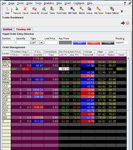Iraj, a useful selection of high probability trading strategies are already littered over the entire site and unfortunately (or fortunately, depending on your viewpoint), don't number that many. But certainly enough to allow any soul competent in basic comprehension and wit the ability to earn a decent living from the markets - all other factors being duly considered and catered for.
I myself have outlined channel and basic S&R strategies (boring, but my bread-and-butter in addition to directionals and vwap [V1.0!]) a number of times in different fora, but unless you happen to post one of these strats on the precise day a bod is looking for one, they get lost, along with most everything else, in the apparently unsearchable vacuum that is the black hole of personal inertia and sagging, possibly non-existent individual motivation that prevents most it would seem from being able to to do anything other than 'check new posts' to see if someone has posted the holy grail today.
Apart from which, this thread is very specifically your approach (and most welcome too IMO) and one which many of us are keen to have you maintain the momentum and direction yourself without it being diverted off down and into the same-old same-old tangents, digressions and divergences that will normally evolve in any thread.
Plus, you're going to have some damn fool BAT-VECTOR float their latest offering to the universe here and then end up with a few hundred posts of nonsense completely derailing your train of thought, and our concentration, which it has to be said, is sorely stretched at times already.
Keep it clean. Keep it Real. HOT Stocks sux. VWAP kicks donkeys...


